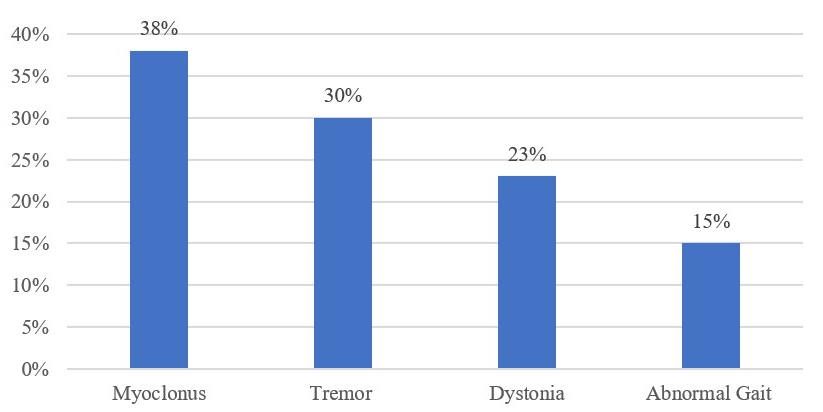Objective: To study the phenomenology of Functional Movement Disorders (FMD) in children.
Background: Data on FMD in children is sparse
Method: The study included 13 children (8 girls and 5 boys) from a tertiary-care centre. Diagnosis of FMD was based on Fahn and Williams criteria. Data included phenomenology, socioeconomic background, electrophysiological, and imaging investigations.
Results: The mean age of onset was 12.1 ± 2.3 years. Sudden onset and triggers like minor injuries and stressors were common precipitants. 68% of the children were from urban areas, 61% belonging to low socioeconomic status and 61.5% with subnormal intelligence. 72% had a precipitating factor. The most common phenomenology was myoclonus (38%), followed by tremor (30%), dystonia (23%), and abnormal gait (15%). Clues to suggest a psychogenic etiology were, isolated or predominant involvement of the dominant upper limb, distractibility, and entrainment in case of tremor. Significant variability in frequency, amplitude, and distribution of the FMD by distracting manoeuvres were helpful in establishing the diagnosis. Tremor and dystonia were more common in girls, while myoclonus was more common in boys. A single movement disorder was present in 10 patients (76%); while 3 patients (24%) had a combination of ≥ 2. 9 patients had other sensory symptoms most commonly headache.
Conclusion: The mean age of onset was 12.1 ± 2.3 years. Sudden onset and triggers like minor injuries and stressors were common precipitants. 68% of the children were from urban areas, 61% belonging to low socioeconomic status and 61.5% with subnormal intelligence. 72% had a precipitating factor. The most common phenomenology was myoclonus (38%), followed by tremor (30%), dystonia (23%), and abnormal gait (15%). Clues to suggest a psychogenic etiology were, isolated or predominant involvement of the dominant upper limb, distractibility, and entrainment in case of tremor. Significant variability in frequency, amplitude, and distribution of the FMD by distracting manoeuvres were helpful in establishing the diagnosis. Tremor and dystonia were more common in girls, while myoclonus was more common in boys. A single movement disorder was present in 10 patients (76%); while 3 patients (24%) had a combination of ≥ 2. 9 patients had other sensory symptoms most commonly headache.
Phenomenology of FMD in children
References: 1.Canavese C, Ciano C, Zibordi F, Zorzi G, Cavallera V, Nardocci N. Phenomenology of psychogenic movement disorders in children. Mov Disord. 2012 Aug;27(9):1153-7
To cite this abstract in AMA style:
A. Cherian, D. Kalikavil Puthanveedu. Phenomenology of Functional Movement Disorders in Children [abstract]. Mov Disord. 2024; 39 (suppl 1). https://www.mdsabstracts.org/abstract/phenomenology-of-functional-movement-disorders-in-children/. Accessed March 31, 2025.« Back to 2024 International Congress
MDS Abstracts - https://www.mdsabstracts.org/abstract/phenomenology-of-functional-movement-disorders-in-children/

